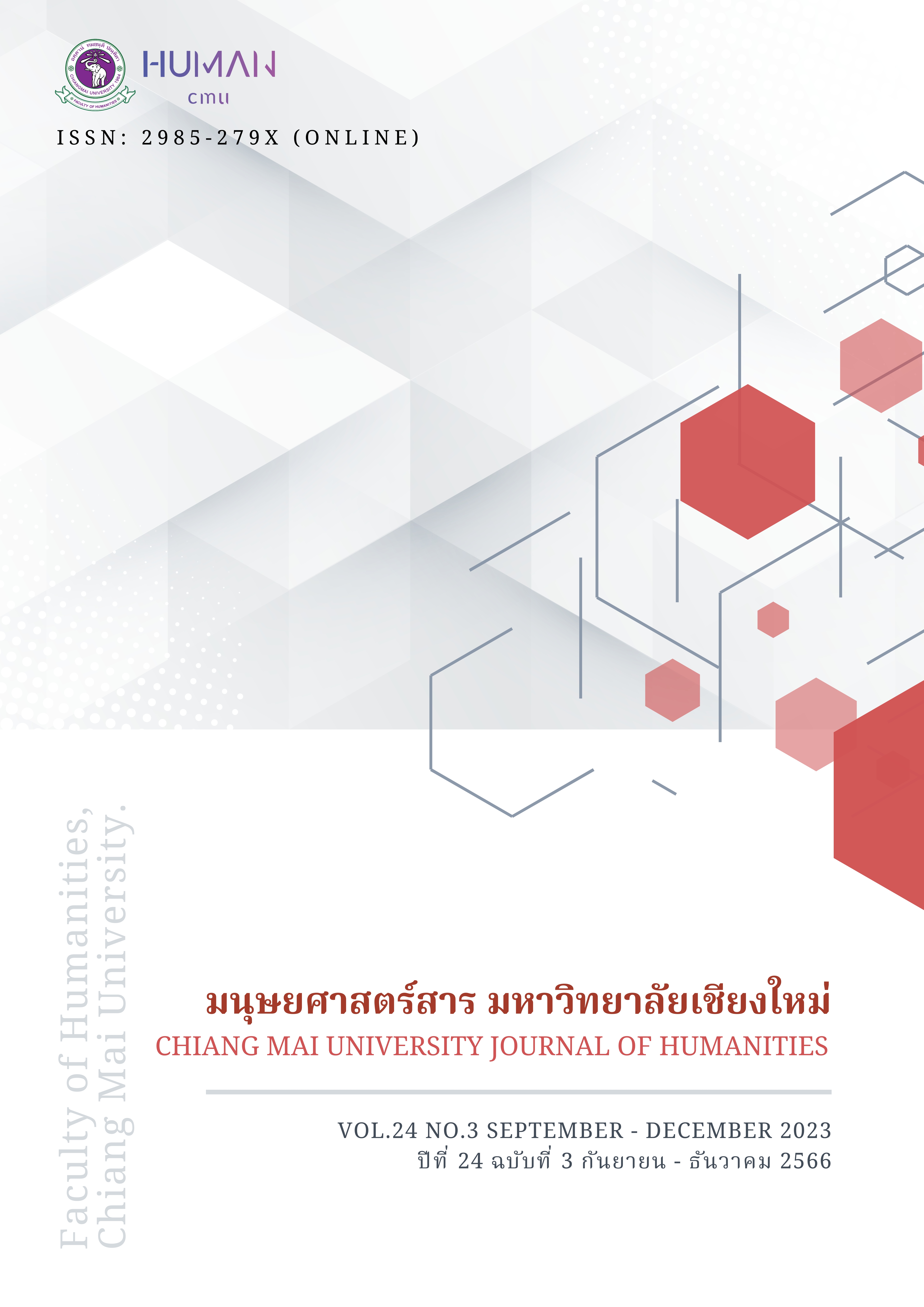ป้ายและชื่อธุรกิจร้านค้าจำหน่ายผลิตภัณฑ์ผ้าทอและเครื่องเงิน ในเขตอำเภอเมืองน่าน จังหวัดน่าน: การศึกษาตามแนวภูมิทัศน์ภาษา
Main Article Content
บทคัดย่อ
งานวิจัยนี้มีวัตถุประสงค์เพื่อวิเคราะห์รูปแบบการใช้ภาษาและลักษณะภาษาบนป้ายร้านค้าจำหน่ายผลิตภัณฑ์ผ้าทอและเครื่องเงินในเขตอำเภอเมืองน่านตามแนวคิดภูมิทัศน์ภาษา (Linguistic Landscape) กลุ่มตัวอย่างในงานวิจัยนี้คือ ป้ายร้านค้าจำหน่ายผลิตภัณฑ์ผ้าทอและเครื่องเงินในเขตอำเภอเมืองน่าน จำนวน 33 ร้าน มีป้ายทั้งหมด 282 ป้าย โดยคัดเลือกกลุ่มตัวอย่างแบบเฉพาะเจาะจง โดยเลือกป้ายต่างๆ บริเวณร้านค้า เห็นได้ชัดเจนทั้งภายในและภายนอกร้านค้า กรอบแนวคิดที่ใช้ในงานวิจัยคือแนวคิดภูมิทัศน์เชิงภาษาศาสตร์ ของ Landry & Bourhis (1997) และ พิชัย แก้วบุตร และนพวรรณ เมืองแก้ว (2563) ผลการวิจัยพบว่า พื้นที่ดังกล่าวสะท้อนความหลากหลายในการใช้ภาษา ได้แก่ ภาษาไทย ภาษาอังกฤษ ภาษาไทยถิ่นเหนือ ภาษาล้านนา และภาษาจีน การปรากฎของภาษาอังกฤษบนป้ายยังสะท้อนให้เห็นถึงเมืองที่มีความเป็นสากล และการยอมรับการเปลี่ยนแปลงเพื่อเข้าร่วมการเป็นส่วนหนึ่งของพลเมืองโลก (World Citizens) นอกจากนี้ ยังสะท้อนให้เห็นถึงความหลากหลายของชาติพันธุ์ ที่เข้ามามีการปฏิสัมพันธ์กันในจังหวัดน่านอีกด้วย การปรากฏของภาษาไทยถิ่นเหนือบนป้าย สะท้อนให้เห็นถึงความต้องการในการรักษาและดำรงไว้ซึ่งความเป็นล้านนาและความเป็นไทย ภายใต้การเปลี่ยนแปลงตามกระแสโลกาภิวัตน์
Article Details

อนุญาตภายใต้เงื่อนไข Creative Commons Attribution-NonCommercial-NoDerivatives 4.0 International License.
เอกสารอ้างอิง
กรกฤช มีมงคล. (2563). ภาษาบนป้าย: การศึกษาด้านวากยสัมพันธ์และวัจนปฎิบัติศาสตร์. วิวิธวรรณสาร,
(2). 187-212.
กฤตพล วังภูสิต. (2562). การวิเคราะห์เปรียบเทียบป้ายชื่อธุรกิจการค้าในย่านบางลำภูกับย่านสยามสแควร์:
ภูมิทัศน์เชิงภาษาศาสตร์. วารสาร Veridian E Journal, 12(2), 20-35.
เก่งภักดี กลิ่นเทศ. (2563). ภูมิปัญญาผ้าซิ่นในคุ้มเจ้านายเมืองน่านสู่การพัฒนาอัตลักษณ์ทางวัฒนธรรม
เพื่อการออกแบบสิ่งทอร่วมสมัย. วารสารมนุษยศาสตร์และสังคมศาสตร์ มหาวิทยาลัยราชภัฏบ้านสมเด็จเจ้าพระยา, 17(1), 156-189.
จารญา อนันตะวัน และศุภกิจบัวขาว. (2565). การศึกษาภูมิทัศน์ภาษาศาสตร์ของตลาดท่าเสด็จ จังหวัด
หนองคาย. วารสารมนุษยศาสตร์และสังคมศาสตร์ มหาวิทยาลัยอุบลราชธานี, 13 (1). 101 – 134.
จริยา เสียงเย็น. (2558). ภูมิทัศน์ทางภาษาจากป้ายโฆษณาในเขตอำเภอเมือง จังหวัดอุดรธานี. วารสารพื้นถิ่น
โขง ชีมูล, 1(2), 18-34.
ถนอมจิตต์ สารอต และ สราวุฒิ ไกรเสม (2562). ความเป็นพหุภาษาในชุมชนเมือง: กรณีศึกษาความสัมพันธ์
ระหว่างภูมิทัศน์ทางภาษากับธุรกิจการค้าย่านนานาฝั่งเหนือ. วารสารภาษาและวัฒนธรรม, 38(1), 24-40.
พงศกร เมธีธรรม. (2560). ภาษาอังกฤษ: มายาคติ อำนาจ และการครอบงำ (พิมพ์ครั้งที่ 1). สำนักพิมพ์
มหาวิทยาลัยนเรศวร.
พิชัย แก้วบุตร. และนพวรรณ เมืองแก้ว. (2563). ป้ายและชื่อธุรกิจการค้าในท่าอากาศยานนานาชาติสุราษฎร์
ธานี: การศึกษาตามแนวภูมิทัศน์ภาษาศาสตร์. วารสารมนุษยศาสตร์และสังคมศาสตร์ มหาวิทยาลัย
อุบลราชธานี, 11(2), 225-252.
พิชัย แก้วบุตร. (2562). ความพร้อมด้านภาษาจีนของท่าอากาศยานนานาชาติจังหวัดสุราษฎร์ธานี กับ MICE
CITY: การศึกษาตามแนวภูมิทัศน์เชิงภาษาศาสตร์. วารสารมนุษยศาสตร์ มหาวิทยาลัยนเรศวร, 17(1).
-104.
มูฮำหมัดสุกรี หะยีสะนี และสมิทธ์ วงศ์วิวัฒน์ (2565). พหุภาษาในเมืองชายแดนใต้ กรณีศึกษาภูมิทัศน์ทาง
ภาษากับป้ายธุรกิจการค้าในเขตอำเภอเมืองยะลา จังหวัดยะลา. วารสารปาริชาต มหาวิทยาลัยทักษิณ
, 35(2), 185-202.
มูฮำหมัดสุกรี หะยีสะนี. (2565). ภูมิทัศน์ทางภาษาบนป้ายร้านกาแฟในเขตชุมชนพหุภาษา. วารสารสงขลา
นครินทร์ ฉบับสังคมศาสตร์และมนุษยศาสตร์, 28(2), 67-81.
ภิญญพันธุ์ พจนะลาวัณย์, อัญธิชา มั่นคง, และ วิศท์ เศรษฐกร. (2560). "ภูมินาม" สามภาษา: การใช้ภาษาไทย
อังกฤษและจีนบนป้ายชื่อสาธารณะเพื่อการท่องเที่ยว ในเขตเทศบาลนครลำปาง. วารสารการบริหาร
ท้องถิ่น. 10(4). 120-138.
สมคิด นันต๊ะ, บัณฑิกา จารุมา. (2565). ถอดบทเรียนกระบวนการและปัจจัยความสำเร็จของการจำหน่าย
สินค้าและผลงานด้านศิลปะในเชิงพาณิชย์ของศิลปินในกลุ่มจังหวัดล้านนา. วารสารปัญญาปณิธาน, 7 (1), 153-166.
สนั่น ธรรมธิ. (2550). พิธีกรรมและความเชื่อ การปลูกเรือนล้านนา. เชียงใหม่: สำนักส่งเสริมศิลปวัฒนธรรม
มหาวิทยาลัยเชียงใหม่.
สำนักงานสถิติจังหวัดน่าน. (2564). ข้อมูลทั่วไปจังหวัดน่าน. สืบค้น วันที่ 11 มกราคม 2566, จาก
https://nan.nso.go.th/reports-publications/provincial-statistics-report.html
หอศิลปวัฒนธรรม เมืองน่าน. (2562). การกำหนดของเขตพื้นที่ใจเมืองน่าน. บริบทเมืองเก่าน่าน.
https://nan-acc.com/บริบทเมืองเก่าน่าน
โอฬาร รัตนภักดี. (2565). คุณค่าของภูมินามหมู่บ้านในจังหวัดน่าน. วารสารวิชาการมหาวิทยาลัยหอการค้า
ไทย มนุษยศาสตร์และสังคมศาสตร์, 42(2), 82-96.
Chongbanjob, W. (1991). A study of language in business naming. (Master of arts thesis,
Thammasat University).
Jing-Jing, W. (2015). Linguistic landscape on campus in Japan: A case study of signs In Kyushe
University. Intercultural communication Studies, 24(1), 123-144.
Jingsi, N. (2018). Language usage of Commercial Names of Business in Yaowarat Area. RSU
National Research Conference 2018, Bangkok, (pp. 479-488). Rangsit University.
Gorter, D. (2006). Introduction: The Study of the Linguistic Landscape as a New Approach to
Multilingualism. In D. Gorter (Ed.), Linguistic Landscape: A New Approach to
Multilingualism (pp. 1 – 6). Clevedon: Multilingual Matters LTD.
Huebner, T. (2006). “Bangkok’s linguistic landscape: environmental print, code mixing and
language change”. International Journal of Multilingualism, 3(1), 31-51.
Khumtong, N. (2014). A study of change in business naming in Sampeng area. (Master of art
thesis, Thammasat University).
Landry, R. & Bourhis, R. Y. (1997). Linguistic Landscape and Ethnolinguistic Vitality: An Empirical
Study. Journal of Language and Social Psychology, 16(1). 23-49.
Nakawat Sareh. (2007). Naming of stores in Changwat Pattani: relationship between store
names and the ways of life in the community. [การตั้งชื่อร้านค้าในจังหวัดปัตตานี: ความสัมพันธ์ระหว่างชื่อร้านค้ากับวิถีชีวิตในชุมชน] (Master of arts thesis, Chulalongkorn University).
Piller, I. (2001). Identity constructions in multilingual advertising. Language in Society, 30(2),
-186.
Rungswang, A. (2018). Linguistic Landscape: Forms and Functions of Signs in Thai Community
Center, Goldern Mile Complex, in Singapore. TNI journal of Business Admiration and Language, 6(1), 35-40.
Siricharoen, A. (2016). Multilingualism in the linguistic landscape of the Faculty of Arts,
Chulalongkorn university, Thailand. MANUSYA: Journal of Humanities, (22), 13-22.
Sirinthorn Pikulthong. (2011). Languages on commercial signs along Phra Athit Road. [ภาษาบน
ป้ายพาณิชย์ของสถานประกอบการย่านถนนพระอาทิตย์] (Master of arts thesis, Silpakorn University).
Srichomthong, P. (2012 ). Identity maintenance in Lanna (Northern Thai). Journal of Southeast
Asian Linguistic Society, (5), 67-84.
Srichomthong, P. (2020). The presence of Kam Mueang on Public Signs as a Reflection of Lanna
Identity. Journal of Humanities, Naresuan University, 19(1). 1-25.
Suaykratok, P. & Manosuthikit, A. (2018). “Inclusion of the minority language on public signs:
multilingualism in the deep south of Thailand”. NIDA Journal of Language and
Communication, 24(23), 3-19.
Thongtong, T. (2016). A linguistic landscape study of signage on Nimmanhemin Road, a Lanna
Chiangmai chill-out street. MANUSYA: Journal of Humanities, 22(Special Issue), 72-87.
Shohamy, Elana & Gorter, Durk. (2009). Linguistic landscape: Expanding the scenery. New York:
Routledge.
Yothinsitikul, S. (2022). Linguistic Landscape from business names in Mueang District, Prayao
Province. Journal of Language and Linguistic Studies, 18(2), 380-389.


